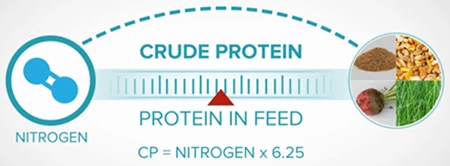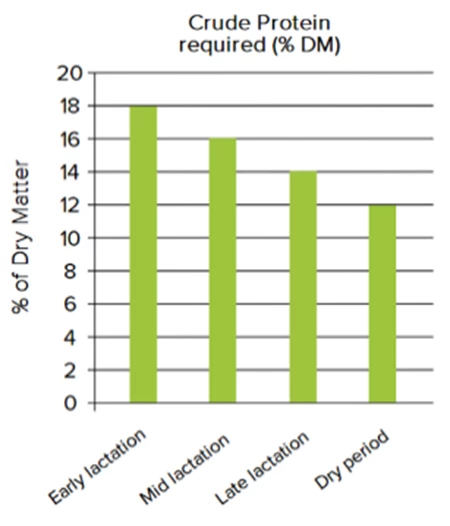Protein
2 min read
Proteins are essential for many metabolic functions in dairy cows, including growth, lactation, and reproduction. This page explains that the protein in feed, known as crude protein (CP), is calculated based on the feed's nitrogen content. The CP a dairy cow needs varies based on factors like lactation stage, milk production, and feed quality. In pasture-based systems, dietary protein generally doesn't limit milk production unless low-protein supplements are used, or during dry summers when pasture protein content decreases. Since cows can't store protein, they need a constant dietary supply but can recycle nitrogen for later use.
Proteins are required by the dairy cow for many metabolic functions e.g. growth, lactation, and reproduction.
Proteins are required by the dairy cow for many metabolic functions e.g. growth, lactation, and reproduction.
The protein content in feed is commonly reported as crude protein (CP). Crude protein is not a direct measure of the protein, but rather an estimate based on the nitrogen (N) content. Protein contains 16% N, so crude protein is calculated by multiplying the N content in the feed by 6.25.

The amount of crude protein (CP) a dairy cow requires depends on:
Generally, in pasture-based systems, dietary protein does not limit milk production.
Exceptions to this are when:

Crude protein includes the true proteins (nitrogen plus amino acids) which can be further broken down into rumen degradable proteins (RDP), which includes soluble proteins and, undegradable dietary proteins (UDP). Crude protein also contains non-protein nitrogen (NPN) and undigestible dietary protein.
Cows cannot store protein, so they need a constant supply from the diet; however, they differ from single-stomached mammals in that they do not need this protein to contain pre-formed amino acids this is because they can use non-protein nitrogen (NPN) sources (e.g. urea) to produce amino acids and generate microbial protein.
Ruminants are also able to recycle nitrogen for later use. If cow protein requirements are greater than protein supply, large amounts of nitrogen can be recycled back to the rumen for use by the rumen microbes, whereas in non-ruminants, nitrogen is almost entirely lost in the urine.
Watch this 10-min FeedRight video to understand:
Video 11:40 min
Now’s the perfect time to check in, plan, and set up for a strong season. We’ve pulled together smart tips and tools to help you stay ahead all winter long.
Whether you prefer to read, listen, or download handy guides, we’ve got you covered with trusted tools to support your journey every step of the way.